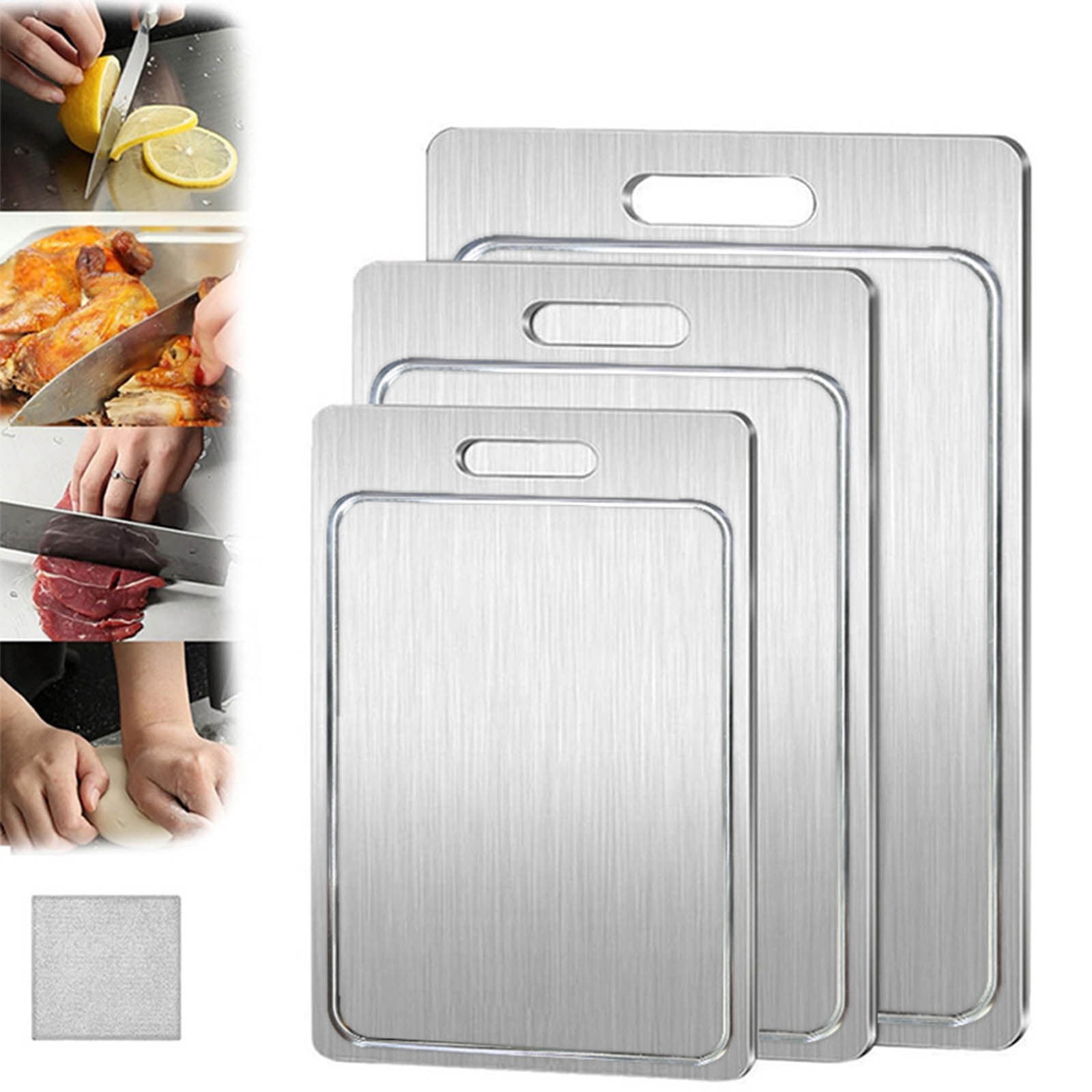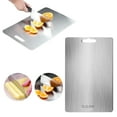Titanium Cutting Board Vs Stainless Steel Cutting Board

The aroma of freshly chopped herbs mingled with the comforting scent of garlic sautéing in olive oil. Sunlight streamed through the kitchen window, illuminating dust motes dancing above the counter. A culinary battle was about to commence, not between chefs, but between two formidable surfaces: the sleek, brushed silver of stainless steel and the cool, gunmetal grey of titanium. The question hung in the air, sharp as a newly honed knife: which cutting board reigns supreme?
At the heart of this kitchen conundrum lies a simple question: Which material provides a safer, more hygienic, and ultimately, a more satisfying food preparation experience? This article delves into the pros and cons of titanium and stainless steel cutting boards, exploring their durability, hygiene, maintenance, and impact on your culinary creations.
The Rise of Alternative Cutting Boards
For generations, wooden cutting boards were the kitchen mainstay. However, concerns about bacteria harboring within the wood's porous surface have spurred the exploration of alternative materials. Plastic cutting boards gained popularity for their affordability and ease of cleaning, but their susceptibility to deep scratches, which can also trap bacteria, raised further concerns.
Enter stainless steel and titanium: materials renowned for their durability, resistance to corrosion, and inherent hygienic properties. But are they truly the superior choices for the modern kitchen?
Stainless Steel: The Kitchen Workhorse
Stainless steel has long been a staple in professional kitchens. Its resistance to rust, stains, and corrosion makes it a practical and reliable choice for demanding environments. Its non-porous surface inhibits bacterial growth, contributing to a safer food preparation environment.
The material is incredibly easy to clean. A simple wash with soap and water is usually sufficient to remove food debris and prevent the buildup of harmful bacteria.
Advantages of Stainless Steel Cutting Boards
One of the primary advantages is its durability. Stainless steel can withstand considerable force and is unlikely to crack or warp, even with heavy use.
Its non-porous surface makes it highly resistant to bacterial contamination, a crucial factor in food safety. Stainless steel is also heat-resistant, allowing you to place hot pots and pans on it without fear of damage.
The affordability is another major selling point. Compared to other premium materials, stainless steel offers a balance of performance and cost-effectiveness.
Disadvantages of Stainless Steel Cutting Boards
Stainless steel can be quite noisy. The clatter of knives against its hard surface can be jarring, especially during extended food preparation sessions.
It can also dull knives more quickly than softer materials like wood or plastic. This necessitates more frequent sharpening and can shorten the lifespan of your cherished blades.
Some users find the cold, hard surface of stainless steel less comfortable to work on compared to warmer materials like wood.
Titanium: The Premium Contender
Titanium, known for its exceptional strength-to-weight ratio and biocompatibility, has found applications in aerospace, medicine, and now, increasingly, in the kitchen. It is highly resistant to corrosion and boasts excellent durability.
Titanium is also hypoallergenic, making it a suitable choice for individuals with sensitivities to certain metals.
Advantages of Titanium Cutting Boards
The exceptional durability of titanium is its defining feature. It can withstand extreme temperatures and is highly resistant to scratches, dents, and corrosion.
Like stainless steel, titanium's non-porous surface inhibits bacterial growth. It contributes to a hygienic food preparation environment. Moreover, proponents claim that titanium cutting boards are gentler on knives than stainless steel, although this is subject to debate.
It has an aesthetic appeal due to its unique color and texture. Titanium cutting boards add a touch of modern elegance to any kitchen.
Disadvantages of Titanium Cutting Boards
The primary drawback of titanium cutting boards is their high cost. Titanium is a relatively rare and difficult-to-process metal, making products made from it significantly more expensive than those made from stainless steel.
While often claimed to be gentler on knives than stainless steel, it can still dull knives faster than softer materials like wood. The difference may be marginal, but it is a factor to consider.
The hardness of the surface can also be noisy, similar to stainless steel, and may not be preferred by all users.
Hygiene: A Crucial Comparison
Both stainless steel and titanium offer superior hygiene compared to wood or plastic. Their non-porous surfaces prevent bacteria from penetrating the material.
Easy to clean, both materials can be sanitized effectively with soap and water or a diluted bleach solution. Proper cleaning practices are essential regardless of the material to prevent cross-contamination.
The Verdict: Which Reigns Supreme?
The choice between stainless steel and titanium cutting boards ultimately depends on your individual needs, preferences, and budget.
If you prioritize affordability, durability, and ease of maintenance, stainless steel is an excellent choice. It provides a reliable and hygienic surface for everyday food preparation.
If you are willing to invest in a premium product and value exceptional durability, hypoallergenic properties, and a unique aesthetic, titanium is a compelling option. However, be prepared to pay a premium for its superior qualities.
Ultimately, the best cutting board is the one that you will use consistently and maintain properly. Regardless of the material, regular cleaning and sanitation are crucial for ensuring a safe and enjoyable culinary experience.
Perhaps the perfect solution lies in having both: a trusty stainless steel board for everyday tasks and a beautiful titanium board for special occasions. After all, in the kitchen, as in life, variety is the spice.


















